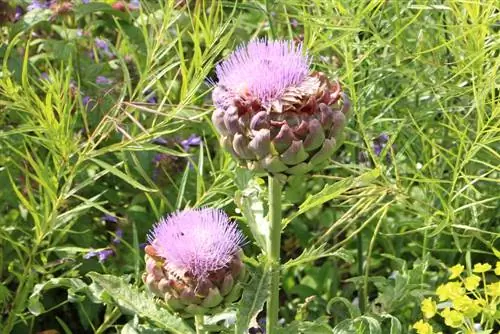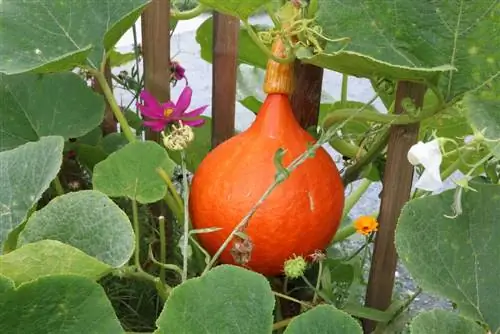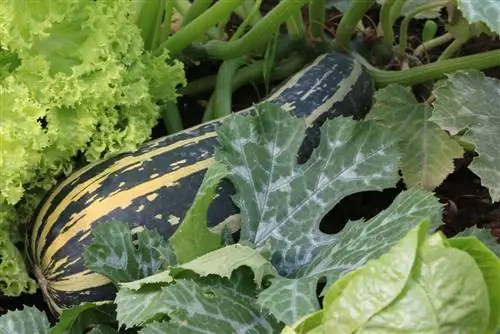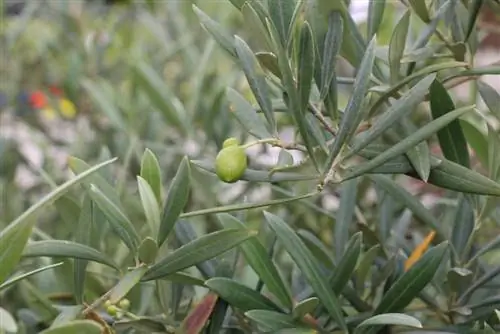- Author admin [email protected].
- Public 2023-12-17 03:39.
- Last modified 2025-01-24 12:45.
Even in ancient Rome, the artichoke was consumed primarily by the upper classes of the population. In the Middle Ages, the plant was valued not only for its taste but also for its medicinal properties, so that it reached Central Europe with wandering monks across the Alps. Here it was mainly grown in princely gardens and monastery gardens. To this day, the plant is considered a gourmet vegetable, which is hardly surprising to knowledgeable gardeners. The creamy artichoke flesh is not only a culinary delight - eating it is also more complex than raising it. The only thing that needs to be done carefully is the timing of the harvest.
Artichokes are very he althy
Artichokes contain the bitter substances cynarin and cynaridin, which have a stimulating effect on the digestive system and also have a beneficial effect on the liver. They are even said to be able to support the regeneration of an already damaged liver. The plant also contains cancer-preventing flavonoids, which also help lower cholesterol levels. Furthermore, these substances are said to have a vascular protective effect. Diabetics tolerate the inulin, a carbohydrate contained in the artichoke, particularly well. However, this can cause bloating in sensitive people. Because of the positive he alth effects of the ingredients, you can buy artichoke preparations as dietary supplements in the pharmacy or he alth food store - or simply grow the plant yourself in the garden.
Growth and appearance
If you want to grow artichokes yourself in the garden, you can grow the plants from seeds on the windowsill from February. The still tender young plants are then placed in the bed after the ice saints - and can grow up to two meters high and just as wide. They are stately perennials that require a lot of space, which the gardener must of course take into account when planting in spring: each artichoke needs at least one square meter of space.
After planting, the plant initially forms a rosette of leaves, from which the flower stalks usually grow out in the second year. With some varieties cultivated as annuals, you can even harvest in the first year of planting. The perennial looks very pretty in the garden thanks to its pinnate, silvery-gray leaves and impressive growth. The inflorescences are - if not harvested - similar to thistles and have numerous purple tubular flowers.
Can you grow artichokes in your home garden?

In a mild winter climate, such as in the German wine-growing regions, the artichoke can be cultivated for several years, but it is not reliably hardy here. Therefore, you should cover it with soil, straw, leaves or a fleece during the cold season. But even those who live in regions with harsher climates don't necessarily have to go without home-grown artichokes. In this case, you can use specially bred annual varieties such as 'Vert Globe', 'Vert de Provence' or 'Imperial Star'. These develop many tasty flower buds in the first year of planting.
If you want to grow artichokes, you have to pay attention to these points:
- Plants from seeds starting in February
- alternative shopping for young plants
- plant in May
- do not tolerate frost
- large space requirement
- need loose, nutrient-rich soil
- full sunny location is preferred
- high nutrient requirements
- fertilize regularly with organic fertilizer
- hoe regularly and loosen the soil
- water when dry
With good growing conditions and appropriate care, you can finally harvest your first home-grown artichoke flowers in the summer.
When are artichokes ready to harvest?
The inflorescences of artichokes are eaten. However, the flowers should still be tightly closed because they are no longer edible once they have opened. They become dry and lose their distinctive taste. Depending on the climate, the harvest period begins in June or July and can extend over several weeks.
However, the plants are very large, but not particularly flowery: under the best conditions, a maximum of six to eight buds develop per plant, with a bit of luck there can be up to twelve - but often there are actually only one to eight two.
This is how you can recognize flower buds that are ready to harvest:
- Flower base fully formed
- green covers still tightly closed
- or. just starting to spread slightly
- Tips of the bracts turn slightly brown
Tip:
You can of course wait until the optimal time to harvest the artichokes - or cut off the tiny, far from ripe flower buds from May / early June. These can be cooked whole and are particularly tender, even if there may not be much to them. At this point new ones are growing.
How are artichokes harvested?
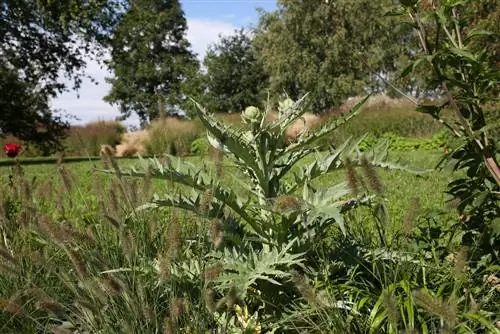
Artichokes are harvested by cutting off the flower bud and the stem underneath with a clean and sharp knife. The flower stalk should be retained, especially if you don't want to process the buds straight away - this will continue to supply the delicacy with moisture and prevent it from drying out. When harvesting, start with the bud on the top shoot of the plant and then harvest from top to bottom.
Store and process artichokes correctly
Artichokes only last a few days in the vegetable compartment of the refrigerator. It's best to wrap them in a damp cloth so that they don't dry out. If the stem is long enough, you can also place the flower buds in a vase for storage.
Preparation should be done as quickly as possible:
- Wash the whole artichoke thoroughly.
- Remove the stem, but do not cut it off!
- Break it off over the edge of a table or similar.
- This is the only way to remove the inedible “hay” inside
- by pulling it out with the handle.
- The tough outer leaves are also removed,
- they are also inedible.
- Drizzle the interfaces immediately with lemon juice
- otherwise they will oxidize and turn an unsightly brown color
- Cook the artichoke in boiling s alted water until al dente
- Cooking time varies between 30 and 45 minutes depending on size
You can also add lemon juice and white wine to the cooking water for a special touch.
How to eat an artichoke in style
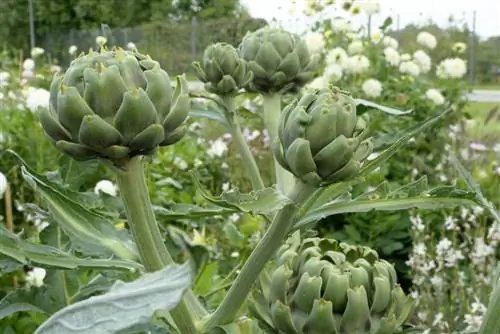
If you prepare the artichoke as described above, you will have removed the inedible parts before eating. Of course, it looks nicer if you cook and serve it whole - then your guests have to work on the bud themselves. To eat, pluck off the flower bracts individually and dip them in a suitable sauce - for example in a cream cheese cream, a herb or tomato sauce or in a vinaigrette made from good olive oil and aromatic herbs.
The creamy artichoke flesh is pulled out from the lower part of the leaves with your teeth. Simply set any remaining coarse fibers aside. The closer you get to the flower base, the more abundant the consumable portion becomes. On the other hand, you eat the delicate flower base with a knife and fork as soon as you have removed the so-called hay - these are excess, hard fibers - from it.
Artichokes are usually eaten as an appetizer. A bowl of water and a small towel to clean your fingers should be available on the table for guests.
Conclusion
Artichokes, which come from the Mediterranean region, have been eaten for thousands of years and are considered a “royal vegetable”. Only the flower buds that have not yet opened are consumed; they are simply cut off along with the stem with a sharp knife and then boiled in s alt water. The right time to harvest is before the scales open and the flowers appear. These are thistle-like and have numerous purple tubular flowers - but are no longer suitable for use in the kitchen. Artichokes are not only a vegetable for gourmets, but are also considered very he althy.

